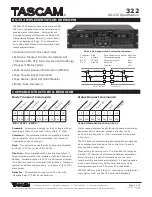
EN
9
During MP3 / WMA CD playback, the directory number
(e.g., 01), current track number (e.g. 001), and elapsed
playing time appears briefly on the LCD, then switches
to show "[MP3]", the current track number and file name.
With the exception of
, information such as track
number, elapsed track playing time, total track time,
battery indicator, and repeat / random playback that is
normally viewed on the player's line remote LCD can be
viewed directly from the Speaker Dock LCD. For MP3 /
WMA CD playback, information such as directory
number and ID3 tagging, if available, are also shown on
the LCD.
The player supports audio track ID3 tagging, which
contains information and data such as title, album or
artist that may be embedded in an MP3 track. Press the
INFO / PROG
button on the player or Speaker Dock to
view the ID3 tag information. If there is no ID3 tag
information, "[MP3] No ID3-Tag" is shown on the LCD.
When all tracks on the CD have finished playing,
the system will automatically stop. If the lid is opened at
anytime during playback, "DOOR OPEN" appears on
the LCD. If no CD is loaded, "NO DISC" appears on the
LCD.
ADJUSTING VOLUME
1. Adjust the volume using the
- / +
buttons on the
player, line remote or Speaker Dock.
2. Press and hold the
- / +
buttons to adjust volume
more quickly.
Volume level on the player ranges from 00 to
32 (default volume level is 10). On the Speaker Dock,
volume level ranges from 00 (shown as "VOL MIN" on
the Speaker Dock LCD) to 40 ("VOL MAX"). Default
volume level is 20.
PAUSE / STOP / PLAY
1. Press the
button on the player, line remote or
Speaker Dock during audio playback to pause. The
elapsed time of the currently played track on the line
remote or Speaker Dock LCD will flash. MP3 / WMA
CDs will show the directory number in addition to
track number and elapsed time.
2. Press the
button again to resume playback.
3. To stop playback, press the button on the player,
line remote or Speaker Dock. The unit enters standby
mode with total number of tracks, total playing time
and "CD" is displayed on the LCD (for MP3 / WMA
CDs, the total number of directories, total number of
tracks and "Track" appear on the LCD).
NOTE
NOTE
4. To turn off the player, press the button on the unit
or line remote again. To power off the player, press
the Speaker Dock
button. The system clock
appears on the LCD.
SKIPPING TRACKS
1. In stop or playback mode, press the
or
button
on the player, line remote or Speaker Dock to skip
the current track and go to the beginning of the
previous or next track.
2. During playback, press the button once to skip to
the beginning of the current track and repeat
playback.
3. During playback, press and hold the or
button
to rewind or fast forward to a different location of the
currently played track. Playing time shown on the
line remote or Speaker Dock LCD changes rapidly.
SELECTING DIFFERENT DIRECTORIES
(MP3 / WMA CDs ONLY)
To select the previous or next directory on an MP3 / WMA
CD, press and hold the
or
button until the desired
directory number (e.g., 10) and track number (e.g., 001)
appear on the line remote or Speaker Dock LCD.
REMOVING DISCS
1. If the player is playing a track, press the button on
the player, line remote or Speaker Dock to stop
playback.
2. Once the disc stops spinning, slide the player's
OPEN
switch to open the player's lid and remove
the CD.
3. If docked, press the
button to power off the
Speaker Dock and unplug its AC adaptor, then
detach the player from unit.
To avoid damaging discs / player and incurring
electric shock, do not stop the CD by hand or try to
remove the player from the Speaker Dock before
powering off and unplugging the AC adaptor.
HOLD FUNCTION
PLAYER
The
HOLD OFF CHG
switch on the player is designed
to prevent accidental selection of an unwanted function
during playback or stop mode.
1. Slide the
HOLD OFF CHG
switch to the
HOLD
position. "HOLD" is shown on the LCD for about
5 seconds. No buttons on the player function when
pressed.
2. To resume normal button operation, slide the
HOLD
OFF CHG
switch to the
OFF
position on the unit.
LINE REMOTE
The
HOLD
switch is also available on the line remote.
Slide
HOLD
to the right on the line remote to activate
and slide to the left to deactivate. "HOLD" is shown on
the LCD for about 5 seconds. No buttons on the line
remote function when pressed.
NOTE
DDM328 Eng R9 OP
5/9/05, 10:02 AM
9
All manuals and user guides at all-guides.com


































